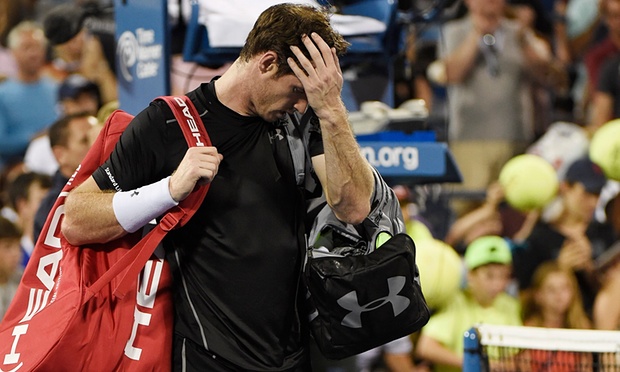


South African beats British No1 7-6, 6-3, 6-7, 7-6
Ends Murray’s run of 18 grand slam quarter-finals
IN a fractious, racket-smashing, sweaty old brawl of a tennis match, splintered with enough oaths to light up a late-night card game, Andy Murray soaked up 25 Kevin Anderson aces but could not stop the giant South African reaching his first grand slam quarter-final, after losing in the fourth-round seven times.
Last week, Murray came from two sets down to stay alive in the tournament where he made his grand slam breakthrough three years ago. Not this time.
Anderson won 7-6 (7-5), 6-3, 6-7 (7-2), 7-6 (7-0) in four hours and 18 minutes, the longest match of the tournament so far. It was a triumph on merit.
For the first couple of hours Murray played ill-conceived, under-powered tennis, as if walking and hitting through treacle. How fitting they were playing on America’s Labor Day.
Too often in the the first two sets – and much of the third – Murray hit short or, with Anderson marauding at the net, popped up returns that begged to be put away by a 6ft 8in opponent whose racket comes down on a smash from something like 12 feet.
Murray also wasted way too many chances, failing to convert eight of 11 break points. Anderson, on the other hand, scrapped like a junkyard dog who hadn’t eaten in a week, and, after a nervous start, hit the ball with flat power and precision on most of the key points, with some superb volleying (48 successful visits to the net in 58 attempts) to complete a performance and victory to rank alongside any in his career – indeed any in this tournament by any of his peers.
“I just managed to keep my composure throughout and probably played one of the best matches of my life,” Anderson said courtside. “He was right in it, such a fighter, such an amazing player. I obviously served very well, couldn’t ask for a better [final tie] break. Beating someone like Andy feels so amazing. Now I’m going to have to do it again.”
That will be on Wednesday against Stan Wawrinka, who earlier brought Donald Young’s American dream to a halt in four sets.
For Murray there could only be regrets, but he had nobody to blame but himself.
Murray must have had nightmares about playing on the court named after Louis Armstrong, the fabled jazz man who once lived nearby. This is his hell hole on the circuit. If they had played What A Wonderful World the irony could not have been more pointed.
In 2010, Wawrinka put Murray out in the third round in four sets here. Three years ago, Murray came from a set and 5-1 down to beat Marin Cilic on the dreaded court. In the first round last year, he was two sets up against Robin Haase, then cramped up badly. Unable to call the trainer, he lost the third. In the fourth, the Dutchman was suffering too and Murray toughed it out. He was back there in the third round against Andrey Kuznetsov, again went two sets up and lost the third, before going through.
Anderson, although second behind Marin Cilic in the tournament aces count with 71 and high on confidence after winning at Winston-Salem, also brought familiarity (without the contempt), as Murray bossed him in the final at Queen’s and soaked up the South African’s power.
“I don’t think this Kevin Anderson was massively different to that one,” Murray said. “It’s a different surface completely. I played him in Miami earlier this year and in Valencia last year. We played close matches there on the hard courts, which is his preferred surface.
“Tonight he served extremely well. The service game I played at 4-1 down [in the second set], I was up 40-love, got broken. That was around the time when I was starting to get the momentum a bit back on my side.
“I broke him straight after that, held serve, then had break points the next game. Maybe if I’d held serve at 40-love, I might have been able to snatch that second set. From there I fought hard through to the end.”
There were a host of highs and lows, with few flat spots, and many memorable ones.
The early anxiety was Anderson’s, as he strained every sinew to hold through three break points and six deuce points over 12 minutes in the fourth game, the sort of pressure that did for Adrian Mannarino and Thomaz Bellucci in the earlier rounds.
A couple of Murray howlers in the 12th game brought the first tie-break. This was Anderson’s neighbourhood. In nine shootouts coming to New York, he’d prevailed eight times. It’s not always the big serve that wins the tie-break, though. Sometimes the unexpected kicks in, like a spectator standing up with his crying child as Murray was in mid-serve. He double-faulted at 2-1 up, from which misery followed.
Murray’s gave up two break points at the start of the second with a double fault, repaired some of the damage with his seventh ace, then failed to pull down a chased-back forehand on the turn when beautifully lobbed. When Anderson held for 3-0, Murray was officially in the muck, a place he knows well, although he has ways of finding the exits too.
But it was Anderson whose court geography held firm, and Murray was returning to the dark territory he inhabited here against Cilic, when he had to come back form a set and 1-5 down. Unlike Cilic – whose talent was not always linked to his temperament – Anderson is Mr Cool.
Murray made him sweat through four deuce points and forced a final forehand long for the break back. Anderson nearly blew the deciding game four times but his 12th ace caught the line and he led by two sets. Murray’s Cilic moment had passed.
At Wimbledon, Anderson was two sets up against Novak Djokovic and could not finish the job. The world No1 held him at bay 7-5 in the fifth that day. Murray’s task was to emulate Djokovic, quite an ask.
He showed disturbing signs of irritation at the start of the third, although things turned for him in the second game, as Anderson double-faulted to give Murray a look, then hit long for the break. Murray’s eighth and ninth aces gave his revival further substance and he was in front on serve after two-and-a-half hours of struggle. But, as the sun set on Armstrong, Anderson came back hard to break, trying his best to eclipse the world No3.
Murray’s frustrations boiled over on the changeover after 11 games when he mouthed to his box from his chair, “Say something! Say something!” They might sensibly have responded, “Get a grip.”
When Anderson won the rally of the match, swivelling to chase down an excellent lob and hit an over-the-shoulder forehand winner with both feet off the ground, the crowd went as wild as Murray must have been feeling with himself.
They went to the tie-break again, and Murray bounced on the balls of his feet like a boxer trailing on points and waiting to come out for the final round of a world title fight. He needed a knockout for a rematch. When Murray clipped the tape to switch at 5-1, the stadium he hates started loving him. “Let’s go, Andy!” they screamed, nobody louder than the young boys to whom he had presented his smashed racket after an earlier tantrum. When he closed it out with his 12th ace to claw back a set, he fist-pumped as if he’d knocked out Floyd Mayweather.
This was now a fight between a proven champion who’d come back from two sets down eight times and was reaching for his 19th straight quarter-final in majors against an opponent who was 0-15 against top 10 players in the big ones.
Murray had to serve twice to stay in the tournament in the fourth set. At 30-all and 5-6, he took a deep breath, missed his first serve, made sure of the second and volleyed the winner, turning with determined satisfaction to his box. An away-swinging ace down the T secured the third tie-break.
A cracking return off a 99mph Murray serve put Anderson 3-0 up in the tie-break, with the ball in hand. A clipped net sent Murray’s backhand long for 4-0. A 25th and final ace at 138mph clipped the centre line for 5-0. Murray pushed a forehand wide and they changed ends with Anderson needing one point to send the former champion home early. Murray’s last shot of the 2015 US Open was a tired forehand that hit the upper part of the net, and they were done.
“That was one of the great tie-breakers you’ll ever see, from a player we thought was running on empty,” John McEnroe observed. He was not wrong. –Guardian.com